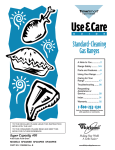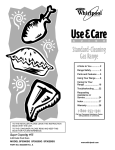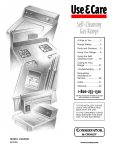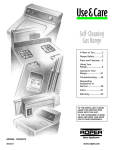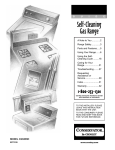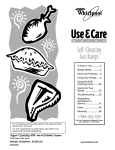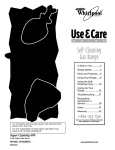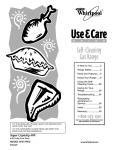Download Whirlpool SF303PEG Specifications
Transcript
Standard-Cleaning Gas Ranges A Note to You............. 2 Range Safety ............. 3 Parts and Features .... 5 Using Your Range ...... 6 Caring for Your Range ...................... 18 Troubleshooting ....... 24 Requesting Assistance or Service ..................... 26 Index ........................ 27 Warranty .................. 28 1-800-253-1301 Call our Consumer Assistance Center with questions or comments. TO THE INSTALLER: PLEASE LEAVE THIS INSTRUCTION BOOK WITH THE UNIT. TO THE CONSUMER: PLEASE READ AND KEEP THIS BOOK FOR FUTURE REFERENCE. 4.65 Cubic Foot Oven MODELS SF3020EG SF302BEG SF303PEG SF306PEG PART NO. 8053370 A NOTE TO YOU Thank you for buying a WHIRLPOOL® appliance. The Whirlpool Brand is committed to designing quality products that consistently perform for you to make your life easier. To ensure that you enjoy years of trouble-free operation, we developed this Use and Care Guide. It is full of valuable information about how to operate and maintain your appliance properly and safely. Please read it carefully. Also, please complete and mail the Product Registration Card provided with your appliance. The card helps us notify you about any new information on your appliance. Please record your model’s information. Whenever you call to request service for your appliance, you need to know your complete model number and serial number. You can find this information on the model and serial number label/plate (see diagram in the “Parts and Features” section). Please also record the purchase date of your appliance and your dealer’s name, address, and telephone number. Model Number Serial Number Purchase Date Dealer Name Dealer Address Dealer Phone Keep this book and the sales slip together in a safe place for future reference. It is important for you to save your sales receipt showing the date of purchase. Proof of purchase will assure you of in-warranty service. Our Consumer Assistance Center number is toll free. 1-800-253-1301 WARNING: If the information in this manual is not followed exactly, a fire or explosion may result causing property damage, personal injury or death. – Do not store or use gasoline or other flammable vapors and liquids in the vicinity of this or any other appliance. – WHAT TO DO IF YOU SMELL GAS • Do not try to light any appliance. • Do not touch any electrical switch; do not use any phone in your building. • Immediately call your gas supplier from a neighbor’s phone. Follow the gas supplier’s instructions. • If you cannot reach your gas supplier, call the fire department. – Installation and service must be performed by a qualified installer, service agency or the gas supplier. 2 RANGE SAFETY Your safety and the safety of others is very important. We have provided many important safety messages in this manual and on your appliance. Always read and obey all safety messages. This is the safety alert symbol. This symbol alerts you to hazards that can kill or hurt you and others. All safety messages will be preceded by the safety alert symbol and the word “DANGER” or “WARNING.” These words mean: wDANGER You will be killed or seriously injured if you don’t follow instructions. wWARNING You can be killed or seriously injured if you don’t follow instructions. All safety messages will identify the hazard, tell you how to reduce the chance of injury, and tell you what can happen if the instructions are not followed. wWARNING Tip Over Hazard A child or adult can tip the range and be killed. Connect anti-tip bracket to rear range foot. Reconnect the anti-tip bracket, if the range is moved. See the installation instructions for details. Failure to follow these instructions can result in death or serious burns to children and adults. Anti-Tip Bracket Range Foot Making sure the anti-tip bracket is installed: • Slide range forward. • Look for the anti-tip bracket securely attached to floor. • Slide range back so rear range foot is under anti-tip bracket. continued on next page 3 RANGE SAFETY IMPORTANT SAFETY INSTRUCTIONS WARNING: To reduce the risk of fire, electrical shock, injury to persons, or damage when using the range, follow basic precautions, including the following: • WARNING – TO REDUCE THE RISK OF TIPPING OF THE RANGE, THE RANGE MUST BE SECURED BY PROPERLY INSTALLED ANTI-TIP DEVICES. TO CHECK IF THE DEVICES ARE INSTALLED PROPERLY, SLIDE RANGE FORWARD, LOOK FOR ANTI-TIP BRACKET SECURELY ATTACHED TO FLOOR, AND SLIDE RANGE BACK SO REAR RANGE FOOT IS UNDER ANTI-TIP BRACKET. • CAUTION – Do not store items of interest to children in cabinets above a range or on the backguard of a range –children climbing on the range to reach items could be seriously injured. • Proper Installation – The range, when installed, must be electrically grounded in accordance with local codes or, in the absence of local codes, with the National Electrical Code, ANSI/NFPA 70. Be sure the range is properly installed and grounded by a qualified technician. • This range is equipped with a three-prong grounding plug for your protection against shock hazard and should be plugged directly into a properly grounded receptacle. Do not cut or remove the grounding prong from this plug. • Disconnect the electrical supply before servicing the appliance. • Never Use the Range for Warming or Heating the Room. • Injuries may result from the misuse of appliance doors or drawers such as stepping, leaning, or sitting on the doors or drawers. • Maintenance – Keep range area clear and free from combustible materials, gasoline, and other flammable vapors and liquids. • Storage in or on the Range – Flammable materials should not be stored in an oven or near surface units. • Top burner flame size should be adjusted so it does not extend beyond the edge of the cooking utensil. For self-cleaning ranges – • Before Self-Cleaning the Oven – Remove broiler pan and other utensils. Wipe off all excessive spillage before initiating the cleaning cycle. – SAVE THESE INSTRUCTIONS – 4 PARTS AND FEATURES Manual oven light switch (p. 23) (Model SF306PEG shown) Oven vent (p. 16) Oven temperature control knob (pp. 12, 14, 15) Surface burners and grates (pp. 6, 18, 19, 20) Electronic clock/timer (pp. 10, 11) Control panel (pp. 5, 18) Automatic oven light switch (p. 23) Anti-tip bracket (p. 17) Door stop clip (pp. 21, 22) Gasket (p. 19) Model and serial number plate (behind left side of broiler door) Broiler door (pp. 14, 15) NOTES: • Window, manual oven light switch, and roll-out broil drawer on models SF303PEG and SF306PEG only. • Electronic clock/timer on model SF306PEG only. CONTROL PANEL Left rear control knob Left front control knob Surface burner marker (shows which burner you are setting) Right front control knob Right rear control knob 5 USING YOUR RANGE USING THE SURFACE BURNERS wWARNING Fire Hazard Do not let the burner flame extend beyond the edge of the pan. Turn off all controls when not cooking. Failure to follow these instructions can result in death or fire. Using the control knobs Your range comes with electric ignitors. Electric ignitors automatically light the burners each time you turn the control knobs to LIGHT. • Place a filled pan on the burner grate before turning on the surface burner. Do not operate a burner for extended periods of time without having cookware on the grate. • Push in the control knob and turn it counterclockwise to the LIGHT position. The clicking sound is the ignitor sparking. Make sure the burner has lit. • To stop the clicking sound after the burner lights, turn the control knob to the cook setting you want. You can set the control knob anywhere between HIGH and LOW. NOTE: All four electric ignitors will click at the same time. However, the burner with the control knob turned to LIGHT is the one that will ignite. 6 Burner heat settings Use the following chart as a guide. SETTING LIGHT RECOMMENDED USE • To light the burner. HIGH • To start food cooking. • To bring liquid to a boil. • To hold a boil. • To fry chicken or pancakes. • For gravy, pudding, and icing. • To cook large amounts of Mid-range (between HIGH and LOW) vegetables. LOW • To keep food warm. • To melt chocolate or butter. • To simmer NOTE: Do not leave empty cookware, or cookware which has boiled dry, on a hot surface burner. The cookware could overheat, causing damage to the cookware or cooking product. Easy ways to save energy • To help shorten your cooking time, use the least amount of liquid possible. • Preheat your pots and pans only when recommended and for the shortest time possible. • Start your food on a higher heat setting, then turn the control to a lower setting to finish cooking. USING YOUR RANGE USING THE SURFACE BURNERS (CONT.) • Refer to your canner manual for specific In case of a prolonged power failure You can manually light surface burners. Hold a lit match near a burner and turn the control knob to the LIGHT position. After the burner lights, turn the control knob to the setting you want. Home canning information The large diameter of most water-bath or pressure canners combined with high heat settings for long periods of time can cause damage to the cooktop. To protect your range: • For best results, use a canner which can be centered over the surface burner. • Do not place your canner on 2 surface burners at the same time. • Start with hot water. This reduces the time the control is set on high. Reduce the heat setting to the lowest position needed to maintain a boil or required pressure levels in a pressure canner. instructions. For up-to-date information on canning, contact your local U.S. Government Agricultural Department Extension Office or companies who manufacture home canning products. Using the right cookware makes a big difference • The pan should have a flat bottom, straight sides, and a well-fitting lid. • Choose medium to heavy gauge (thickness) cookware. • The pan material (metal or glass) affects how quickly and evenly the pan heats. • When using glass or ceramic cookware, check to make sure it is suitable for use on surface burners. • To avoid tipping, make sure pots and pans are centered on the grates. CHARACTERISTICS OF COOKWARE MATERIALS The pan material affects how fast heat transfers from the surface cooking area through the pan material and how evenly heat spreads over the pan bottom. Choose pans that provide the best cooking results. Aluminum • Heats quickly and evenly. • Use for all types of cooking. • Medium or heavy thickness is best for most cooking. • Used as a core or base in cookware to provide even heating. Cast iron • Heats slowly and evenly. • Good for browning and frying. • Maintains heat for slow cooking. • Can be coated with porcelain enamel. Ceramic or ceramic glass • Heats slowly and unevenly. • Use on low to medium settings. • Follow manufacturer’s instructions. Copper • Heats very quickly and evenly. • Used as a core or base in cookware to provide even heating. Earthenware • Can be used for cooktop cooking if recommended by the manufacturer. • Use on low settings. Porcelain enamel-on-steel or enamel-on-cast iron • See cast iron and stainless steel. Stainless steel • Heats quickly but unevenly. • A core or base of aluminum or copper on the cookware provides even heating. • Can be coated with porcelain enamel. 7 USING YOUR RANGE USING THE OVEN Positioning racks and pans Place the oven racks where you need them before Where to place pans: turning on the oven. WHEN YOU HAVE • To move a rack, pull it out to the stop position, 1 pan raise the front edge and lift it out. 2 pans • Be sure the rack(s) is level. Use pot holders or oven mitts to protect your hands • if rack(s) must be moved while the oven is hot. 3 or 4 pans • For best performance, cook on one rack. Place the rack so the top of the food will be centered in the oven. • When cooking with two racks, arrange the racks on the 2nd and 4th rack guides. Two sheets of cookies may be baked if sheets are switched at approximately three quarters of the total bake time. Increase baking time, if necessary. • For best results allow 2 inches of space around each pan and between pans and oven walls. Extra oven rack position (roasting rack) Use this rack position when roasting food too large to be placed on the first rack position. For proper roasting, follow these guidelines: • To avoid spillage, remove food before pulling out the rack. • Tilt the rack up at the front before pulling it over Extra oven rack position the door. • Use an adequate amount of liquid in the pan (meat juices or water) so your food does not get overdone. 8 PLACE In center of the oven rack. Side by side or slightly staggered. In opposite corners on each oven rack. Stagger pans so no pan is directly over another. USING YOUR RANGE USING ALUMINUM FOIL • Use aluminum foil to catch spillovers from pies or casseroles by placing foil on the oven rack below. Foil should be turned up at edges and be at least 1 inch larger than dish. • Do not cover the entire rack with aluminum foil. It will reduce air circulation and give you poor cooking results. • Do not line the oven bottom with foil or other liners. It could affect the oven surface as well as the quality of your baking. • Place tent-shaped foil loosely over meat or poultry to slow down surface browning for long term roasting. Remove foil for the last 30 minutes. • Use narrow strips of foil to shield piecrust edges if browning too quickly. BAKEWARE CHOICES Baking performance is affected by the type of bakeware used. Use the bakeware size recommended in the recipe. BAKEWARE TYPE BEST USED FOR GUIDELINES Light colored aluminum • Light golden crusts • Even browning • Use temperature and time recommended in recipe. Dark aluminum and other bakeware with dark, dull, and/or non-stick finish • Brown, crisp crusts • May reduce baking temperature 25°F. • Use suggested baking time. • Use temperature and time recommended in recipe for pies, breads, and casseroles. • Place rack in center of oven. Ovenproof glassware, ceramic glass, or ceramic • Brown, crisp crusts • May reduce baking temperature 25°F. Insulated cookie sheets or • Little or no bottom browning baking pans • Place in the bottom third of oven. • May need to increase baking time. Stainless steel • Light, golden crusts • Uneven browning • May need to increase baking time. Stoneware • Crisp crusts • Follow manufacturer's instructions. 9 USING YOUR RANGE THE ELECTRONIC TIME-OF-DAY (TOD) CLOCK/TIMER (MODEL SF3O6PEG) Electronic display Clock pad (p. 10) Increase pad (p. 10, 11) CLOCK TIMER TIMER Decrease pad (p. 10, 11) Oven timer pad (p. 11) Display/clock • When showing the time of day, the display will • When you first plug in the range, the entire show the hour and minutes. • When you are using the timer, the display will show seconds for time less than 1 minute, minutes for time less than 1 hour, and hours and minutes for time over 1 hour. The timer indicator will be lit when in the timer mode. display appears followed by a flashing time-ofday. If, after you set the clock (see “Setting the clock” section), the display flashes, your electricity was off for a while. Reset the clock. • When you are not using the oven, the display shows the time of day. SETTING THE CLOCK (MODEL SF3O6PEG) 1. Press CLOCK. The colon flashes during PRESS YOU SEE PRESS YOU SEE PRESS YOU SEE clock programming. 2. Set the time. Press the “up” (▲) or “down” (▼) pad(s) until the correct time shows on the display. NOTE: Press a pad briefly to change time by a small amount. Press and hold a pad to change time by 10 minute increments. 3. Press CLOCK again to start the clock. The colon stops flashing when the clock is active. 10 USING YOUR RANGE USING THE ELECTRONIC TIMER (MODEL SF3O6PEG) The timer does not start or stop the oven. It works like a kitchen timer. It can be set in hours and minutes up to 12 hours, 59 minutes. The timer will display minutes for settings under 1 hour and hours and minutes for settings over 1 hour. You will hear four 1-second tones when the set time is up. NOTE: To display the time of day while the timer is counting down, press CLOCK. Time of day will be displayed for 5 seconds before returning to the timer countdown. 1. Press TIMER. The colon flashes during timer PRESS YOU SEE PRESS YOU SEE programming. 2. Set the interval to be timed. Press the “up” (▲) or “down” (▼) pad(s) until the correct time shows on the display. The timer will begin counting down 5 seconds after the time is set. 3. When there is 1 minute of time remaining, you YOU SEE will hear one tone. The display will then begin counting down in seconds. (display counts in seconds) When the timer countdown reaches zero, the display will show “End” and you will hear four 1-second tones. YOU SEE To return to time-of-day mode: Press TIMER once. PRESS YOU SEE To cancel the timer: Press TIMER twice while in the timer mode. (time of day) 11 USING YOUR RANGE BAKING/ROASTING IMPORTANT: Do not attempt to light the oven burner during a power failure. Roasting meats and poultry 1. Place racks where you need them. For more shallow pan. This keeps the meat out of the drippings and allows the heat to circulate better. • Use a meat thermometer for the most accurate doneness. Insert it so the tip is in the center of the largest muscle or thickest portion of the meat or poultry. Make sure the thermometer is not touching bone, fat, or the bottom of the pan. Front information, see “Positioning racks and pans” in the “Using the oven” section. • For even cooking, place the meat on a rack in a Saving energy • To avoid loss of heat, open the oven door as little Rear 2. Push in and turn the oven temperature control knob counterclockwise to the baking/roasting temperature you want. The oven burner will light by itself in 50-60 seconds. 3. When baking, preheat the oven before putting food into it. During baking/roasting, the oven burner will turn on and off to keep the oven temperature at the selected setting. as possible. Use • a timer to keep track of cooking time. • Plan your meals for the most efficient use of the oven by cooking more than one food at a time, or baking while the oven is still hot after cooking a meal. Rack placement for specific foods: FOOD RACK POSITION Frozen pies, large roasts, turkeys, angel food cakes 1st or 2nd rack guide from bottom Bundt cakes, most quick breads, yeast breads, casseroles, meats 2nd rack guide from bottom Cookies, biscuits, muffins, cakes, nonfrozen pies 2nd or 3rd rack guide from bottom NOTE: Do not place food directly on the oven door or the oven bottom. If you want, place the food on the rack at the extra rack position. NOTE: For information on where to place your rack when broiling, see “Broiling guidelines” later in this 4. After baking/roasting, turn the oven temperature section. control knob clockwise to OFF. 12 USING YOUR RANGE ADJUSTING THE OVEN TEMPERATURE CONTROL Although your new oven is properly adjusted to provide accurate temperatures, it may cook faster or slower than your old oven. If you are not satisfied with the baking/roasting results, you can change the temperature calibration by following the steps below. NOTE: DO NOT measure the oven temperature with a thermometer. Opening the oven door will lower the oven temperature and give you an incorrect reading. Also, the thermometer temperature reading will change as your oven cycles. 1. Make sure the oven temperature control knob is turned to the off position. Pull the knob straight off and flip it over. 2. Loosen the locking screws inside the control knob. Notches COOLER E HOTTER G E G 1 NOTCH = 5˚F Note the position of the notches. Locking screws 3. Adjust the temperature. To lower To raise 1 NOTCH = 5˚F G G Tooth COOLER HOTTER handle firmly and turn the skirt counterclockwise to move the tooth a notch to the “G” on the “COOLER” arrow. • To raise the temperature, hold the knob handle firmly and turn the skirt clockwise to move the tooth a notch to the “G” on the “HOTTER” arrow. Each notch equals about 5°F. E E • To lower the temperature, hold the knob Notches Skirt 4. Tighten the locking screws and replace the COOLER E HOTTER G E G 1 NOTCH = 5˚F control knob. Locking screws 13 USING YOUR RANGE BROILING (MODELS SF3O2OEG AND SF3O2BEG) Broiler pan and grid The broiler is located below the oven door. Always broil with the broiler and oven doors closed. 4. Close the broiler door. NOTES: • Do not step on or apply weight to the broiler door when it is open. This could damage the door. • Do not preheat the broiler before using it, unless your recipe recommends it. Completely close the broiler door during broiling. 1. Open the broiler door. Pull out the broiler pan and grid. 5. Push in and turn the oven temperature control knob counterclockwise to BROIL. The broiler will automatically light in 50-60 seconds. 2. Place the grid on the broiler pan so grease can drain down into the lower part of the broiler pan. 6. After broiling, turn the oven temperature control knob clockwise to OFF. 3. Before the broiler is turned on, place your food on the broiler pan. Then place the pan on the broiler bottom (Position Position 2 0) or one of the two Position 1 other positions. Position 0 14 USING YOUR RANGE BROILING (MODELS SF3O3PEG AND SF3O6PEG) Broiler pan and grid The broiler is located below the oven door. The broiler pan and grid roll out for easy access. Always broil with the broiler and oven doors closed. 4. Close the broiler door. NOTES: • Do not step on or apply weight to the broiler door when it is open. This could damage the door. • Do not preheat the broiler before using it, unless your recipe recommends it. Completely close the broiler door during broiling. 1. Open the broiler door and roll out the broiler pan and grid. 5. Push in and turn the oven temperature control knob counterclockwise to BROIL. The broiler will automatically light in 50-60 seconds. 2. Place the grid on the broiler pan so grease can drain down into the lower part of the broiler pan. 6. After broiling, turn the oven temperature control knob clockwise to OFF. 3. Before the broiler is turned on, place your food on the broiler pan. Then place the pan on the broiler bottom (Position 0) or one of the Position 2 two other positions and Position 1 roll the broiler pan grid Position 0 into the broiler. continued on next page 15 USING YOUR RANGE BROILING (CONT.) Broiling guidelines Recommended pan positions are numbered from bottom (0) to top (2) (see “Broiler pan and grid” earlier in this section.) For best results, place food 3 inches or more from the broil burner. You should rotate the broiler pan back to the front at the same time you turn the foods. APPROXIMATE TIME (MINUTES) PAN POSITION MEAT SIDE 1 SIDE 2 10-12 12-14 16-17 5-6 6-7 8-9 Steak, 1" thick medium-rare medium well-done 1 Ground Meat Patties, 3⁄4" thick, well-done 1 11-13 6-7 Pork Chops, 1" thick 0 19-21 9-10 Ham Slice, ⁄ " thick, precooked 1 6-8 3-4 Frankfurters 1 5-6 2-3 Chicken bone-in pieces boneless breasts 0 1 15-17 11-13 15-17 11-13 Fish, 1⁄2-3⁄ 4" thick fillets 1 7-8 3-4 12 Times are guidelines only and may need to be adjusted to individual tastes. THE OVEN VENT Hot air and moisture escape from the oven through a vent that is near the middle of the backguard. The vent lets air circulate properly. Be careful not to block the vent, or you will get poor baking/roasting results. NOTE: Never store plastics, paper, or other items that could melt or burn near the oven vent, or any of the surface burners. 16 Oven vent USING YOUR RANGE THE ANTI-TIP BRACKET The range will not tip during normal use. However, the range can tip if you apply too much force or weight to the open door without the anti-tip bracket fastened down properly. wWARNING Tip Over Hazard A child or adult can tip the range and be killed. Connect anti-tip bracket to rear range foot. Reconnect the anti-tip bracket, if the range is moved. See the installation instructions for details. Failure to follow these instructions can result in death or serious burns to children and adults. Anti-Tip Bracket Range Foot Making sure the anti-tip bracket is installed: • Slide range forward. • Look for the anti-tip bracket securely attached to floor. • Slide range back so rear range foot is under anti-tip bracket. 17 CARING FOR YOUR RANGE wWARNING Explosion Hazard Do not store flammable materials such as gasoline near this appliance. Doing so can result in death, explosion, or fire. CLEANING CHART Before cleaning, always make sure all controls are off and the range is cool. Refer to instructions on all cleaning products before using them to clean your range. PART CLEANING METHOD SPECIAL INSTRUCTIONS Control Knobs • Soap and water • Dishwasher • DO NOT use steel wool or abrasive cleaners. • Pull knobs straight away from control panel. • Wash, rinse and dry with soft cloth. Control Panel • Soap and water • Wash, rinse and dry with soft cloth. • Spray glass cleaner • Apply spray cleaner to paper towel, do not spray directly on panel. Exterior Surfaces* (excluding control panel and oven door glass) • Soap and water • Mild liquid cleaner • Spray glass cleaner • DO NOT use abrasive or harsh • Non-abrasive plastic scrubbing pad • Gently clean around the model cleaners like chlorine bleach, ammonia or oven cleaners. • Wash, rinse and dry with soft cloth. and serial plate, too much scrubbing could remove the numbers. NOTE: To avoid product • damage, do not remove the cooktop. Surface burner grates* • Light to moderate soil • Soap and water • Non-abrasive plastic scrubbing pad • Clean as soon as they become dirty. • Wash, rinse and dry well. • Dishwasher • Heavy burned on soils • Non-abrasive plastic scrubbing pad • Mild abrasive powdered cleanser and water • Repeat steps of cleaning process (with items at left) as needed, until soil is completely removed. • Rinse thoroughly and dry. *When the cooktop is cool, remove all spills and clean. Food spills containing acids, such as vinegar and tomato, may affect the finish. 18 CARING FOR YOUR RANGE CLEANING CHART (CONT.) PART CLEANING METHOD Surface burners SPECIAL INSTRUCTIONS • See “Lift-up cooktop and surface burners” in the “Caring for your range” section. Oven door glass (Models SF303PEG and SF306PEG) • Wash, rinse and dry with soft • Soap and water cloth. • Non-abrasive plastic scrubbing pad • Wipe with paper towel. • Spray glass cleaner Oven cavity • Food spills containing sugar and/or milk • Soap and water • Heavily soiled areas • When oven cools, wash, rinse and dry with soft cloth. • Steel wool pad • Commercial oven cleaner • Wipe with clean water and dry well. • Follow the directions that come with the oven cleaner. (Place newspaper on the floor to protect the floor surface.) Wipe well with clean water and dry. NOTES: • Use oven cleaners in a well-ventilated room. • Do not let commercial oven cleaners contact the gasket, thermostat, or exterior surfaces of the range. This will cause damage. • For easier cleaning, you can remove the oven door. Carefully follow the instructions in the “Removing the oven door” section. Oven racks • Soap and water • Steel wool pad • Wash, rinse and dry. Broiler pan and grid • Soap and water • Steel wool pad • Dishwasher • Solution of 1/2 cup ammonia to • Wash, rinse and dry. 1 gallon water • Mild abrasive cleanser or commercial oven cleaner • Soak for 20 minutes, then scrub with plastic scrubbing pad. 19 CARING FOR YOUR RANGE LIFT-UP COOKTOP AND SURFACE BURNERS 1. Remove the surface burner grates. 2. Lift the front of cooktop at both front corners until the support rods lock into place. NOTE: Do not drop the cooktop. Damage could result to the porcelain and the cooktop frame. 5. Check the burner flames once in a while for proper size and shape as shown. A good flame is blue in Ports color. If flames lift away 1 " from ports, are yellow, 2 or are noisy, turn off the burner. Allow the burner to cool and follow Step 6. If you still have a problem, contact an authorized service technician to check the air/gas mixture or see the Installation Instructions. 6. If the ports are clogged, clean with a straight pin. DO NOT enlarge or distort the ports. DO NOT use a toothpick to clean the ports. Toothpick pieces may clog the ports. 3. Wipe the surface under the cooktop with warm, soapy water and a sponge. Use a soapfilled plastic scrubbing pad on heavily soiled areas. 7. To lower the cooktop, lift the cooktop from both sides while pressing the support rods back to unlock them. Lower the cooktop into place. 4. Wipe off the surface burners with warm, soapy water and a sponge after each use. To remove cooked-on food, soak the burners in a vinegar and water solution for 20-30 minutes. Then scrub them with a plastic scrubbing pad. (See the “Cleaning chart” section for more information.) 20 8. Replace the surface burner grates. CARING FOR YOUR RANGE REMOVING THE OVEN DOOR For normal use of your range, you do not need to remove the door. However, if you find it necessary to remove the door, follow the instructions in this section. Door removal pin hole Door stop clip NOTE: The oven door is heavy. Before removing the door: 1. Use a putty knife or screwdriver and insert it at the bottom corner of the door stop clip. 2. Pry door stop clip free and remove from front frame hinge slot. Take care not to scratch porcelain. 3. Repeat procedure for other door stop clip. Range Hinge hanger Front frame hinge slot To remove: 1. Open the oven door. Insert door removal pins, included with your range, into both hinge hangers. Do not remove the pins while the door is removed from the range. 2. Carefully close the door until it rests against the door removal pins. 3. Grasp the door on the sides with your fingers on the front of the door and your thumbs on the inside surface. 4. Pull door straight up, then toward you. Hinge hangers will slide out of front frame hinge slot. To replace: NOTE: The door removal pins you inserted must still be in both door hinges. 1. Grasp the door on the sides with your fingers on the front of the door and your thumbs on the inside surface. continued on next page 21 CARING FOR YOUR RANGE REMOVING THE OVEN DOOR (CONT.) 2. Hold oven door so that the top edge of each hinge hanger is horizontal. Insert hinge hangers into the front frame hinge slots. 3. Rotate top of door toward range. Slide hinge hangers down onto front frame support pins. NOTE: Make sure the hinge hangers are fully seated and engaged on the support pins. 4. Insert the door stop clip with the angular surface at the top of the frame hinge slot, then push in the bottom of the clip until flanges are flush with the front frame. 5. Open the door completely and remove the door removal pins. Save door removal pins for future use. 6. Close the door. Door stop clip Door removal pin hole Front frame hinge slot REMOVING THE OVEN BOTTOM You can remove the panel in the oven bottom for cleaning. To remove: 1. Let oven cool. 2. Remove the oven racks. 3. Remove the 2 hold-down screws at the rear of 22 Hinge hanger Support pins Door removal pin hole the oven. If the screws are too tight to remove by hand, use a screwdriver. Range Remove Angular surface of door stop clip CARING FOR YOUR RANGE REMOVING THE OVEN BOTTOM (CONT.) 4. Place your fingers in the slots in the bottom panel and lift the rear of the panel up and back until the lip at the front of the panel is clear of the front frame of the oven cavity. 5. Lift the bottom up and out. Lip To replace: Reverse the steps above. THE OVEN LIGHT (MODELS SF3O3PEG AND SF3O6PEG) The oven light will come on when you open the oven door. To turn the light on or off when the oven door is closed: • Push the oven light switch on the backguard. To replace the oven light: 1. Unplug range or disconnect power. 2. Remove the glass bulb cover in the back of 4. Replace the light bulb cover by turning it clockwise. the oven by turning it counterclockwise. 5. Plug in range or reconnect power. 3. Remove the light bulb from its socket. Replace the bulb with a 40-watt appliance bulb. 23 TROUBLESHOOTING Most cooking problems often are caused by little things you can find and fix without tools of any kind. Check the lists below and on the next page before calling for assistance or service. If you still need help, see “Requesting Assistance or Service” on page 26. RANGE DOES NOT WORK PROBLEM CAUSE Nothing works • The range is not plugged into a properly grounded outlet (120v polarized). • The range is not properly connected to the gas supply. Contact an authorized service technician to reconnect the range to the gas supply. (See the Installation Instructions.) • You have blown a household fuse or tripped a circuit breaker. OVEN/BROILER BURNER PROBLEM CAUSE The oven does not work • You have not turned the oven temperature control knob to a temperature setting. (See “Adjusting the oven temperature control” section.) • The main or regulator gas shutoff valve is in the off position. (See the Installation Instructions.) The burner fails to light The burner flames lift away from the ports, are yellow, or are noisy 24 • The ignitor is broken. Contact an authorized service technician to replace it. • You have blown a household fuse or tripped a circuit breaker. • The air/gas mixture is incorrect. Contact an authorized service technician to check the air/gas mixture or see the Installation Instructions. TROUBLESHOOTING SURFACE BURNERS PROBLEM CAUSE The burner fails to light • The control knob is not set correctly. Push in the control knobs before turning them. Make sure the control knob is turned to the Light position. (See page 6.) • You have blown a household fuse or tripped a circuit breaker. • The burner ports may be clogged. Clean them with a straight pin. (See page 20.) The burner flames are uneven • The burner ports may be clogged. Clean them with a straight pin. (See The burner flames lift off the ports, are yellow, or are noisy when turned off • The burner needs cleaning. (See pages 19 and 20.) • The air/gas mixture is incorrect. Contact an authorized service technician to The burner makes a popping noise when on • The burner is wet from washing. Let it dry. page 20.) check the air/gas mixture or see the Installation Instructions. COOKING RESULTS PROBLEM SOLUTION Cookware not level on cooktop (Check to see if liquids are level in cookware) • Level the range. (See the Installation Instructions.) • Use cookware with a flat bottom. Excessive heat on cooktop in areas around cookware • Choose cookware the same size or slightly larger than the burner flame. The oven temperature seems too low or too high • Adjust the oven temperature control. (See “Adjusting the oven temperature Slow baking or roasting • Increase baking or roasting time. • Increase temperature 25° F. • Preheat oven to selected temperature before placing food in when control” section.) preheating is recommended. • Choose bakeware that will allow 2 inches of air space around all sides. • Open oven door to check food when timer signals shortest time suggested in recipe. • Oven peeking can make cooking times longer. Baked items too brown on bottom Unevenly baked items Crust edge browns before pie is done • Preheat oven to selected temperature before placing food in oven. • Choose bakeware that will allow 2 inches of air space around all sides. • Position rack higher in oven. • Decrease oven temperature 15° to 25° F. • Level the range. • Bake in center of oven with 2 inches of space around each pan. • Check to make sure batter is level in pan. • Shield edge with foil. If none of these items are causing your problem, see “Requesting Assistance or Service” on page 26. 25 REQUESTING ASSISTANCE OR SERVICE To avoid unnecessary service calls, please check the “Troubleshooting” section. It may save you the cost of a service call. If you still need help, follow the instructions below. IF YOU NEED ASSISTANCE OR SERVICE Call the Whirlpool Consumer Assistance Center toll free at 1-800-253-1301. Our consultants are available to assist you. When calling: Please know the purchase date, and the complete model and serial number of your appliance (see the “A Note to You” section). This information will help us better respond to your request. Our consultants provide assistance with: • Features and specifications on our full line of appliances • Installation information • Use and maintenance procedures • Accessory and repair parts sales • Specialized customer assistance (Spanish speak- ing, hearing impaired, limited vision, etc.) • Referrals to local dealers, service companies, and repair parts distributors Whirlpool service technicians are trained to fulfill the product warranty and provide after-warranty service, anywhere in the United States. To locate the authorized Whirlpool service company in your area, you can also look in your telephone directory Yellow Pages. IF YOU NEED REPLACEMENT PARTS If you need to order replacement parts, we recommend that you only use FSP® factory authorized parts. FSP replacement parts will fit right and work right, because they are made to the same exacting specifications used to build every new WHIRLPOOL® appliance. To locate FSP replacement parts in your area, call our Consumer Assistance Center telephone number or your nearest authorized service center. FOR FURTHER ASSISTANCE If you need further assistance, you can write to Whirlpool with any questions or concerns at: Whirlpool Brand Home Appliances Consumer Assistance Center c/o Correspondence Dept. 2000 North M-63 Benton Harbor, MI 49022-2692 26 Please include a daytime phone number in your correspondence. INDEX TOPIC PAGE TOPIC PAGE ANTI-TIP BRACKET ................................................... 17 FEATURES ................................................................... 5 ASSISTANCE ............................................................. 26 LIFT-UP COOKTOP ................................................... 20 BAKING Aluminum foil ............................................................ 9 Bakeware .................................................................. 9 Pans ................................................................... 8, 12 Racks .................................................................. 8, 12 Setting cycle ........................................................... 12 Tips ......................................................................... 12 MODEL AND SERIAL NUMBER .................................. 2 BROILING Broiler ............................................................... 14, 15 Grid ................................................................... 14, 15 Guidelines ............................................................... 16 Pan ................................................................... 14, 15 Setting cycle (Models SF3020EG and SF302BEG) .. 14 Setting cycle (Models SF303PEG and SF306PEG) .. 15 CLEANING Broiler pan and grid ................................................ 19 Control knobs ......................................................... 18 Control panel .......................................................... 18 Exterior surfaces .................................................... 18 Oven cavity ............................................................. 19 Oven door glass ..................................................... 19 Oven racks ............................................................. 19 Surface burners ................................................ 19, 20 Surface burner grates ............................................. 18 CONTROL PANEL Burner heat settings ................................................. 6 Control knobs ........................................................... 6 Surface burner markers ............................................ 5 COOKWARE Canning .................................................................... 7 Materials ................................................................... 7 Tips ........................................................................... 7 OVEN Bottom .............................................................. 22, 23 Door .................................................................. 21, 22 OVEN LIGHT (Models SF303PEG and SF306PEG .... 23 OVEN TEMPERATURE Adjusting ................................................................ 13 Setting .................................................................... 12 OVEN VENT ............................................................... 16 PANS ...................................................................... 8, 12 PARTS .......................................................................... 5 RACKS ................................................................... 8, 12 ROASTING Pans ................................................................... 8, 12 Racks .................................................................. 8, 12 Setting cycle ........................................................... 12 Tips ......................................................................... 12 SAFETY .................................................................... 3, 4 SERVICE .................................................................... 26 SURFACE BURNERS Control knobs ..................................................... 6, 18 Control setting guide ................................................ 6 Power failure ............................................................. 7 Surface burner markers ............................................ 5 TROUBLESHOOTING .......................................... 24, 25 WARRANTY ............................................................... 28 ELECTRONIC TIME-OF-DAY CLOCK/TIMER Clock ...................................................................... 10 Display .................................................................... 10 Timer ...................................................................... 11 27 NOTES WARRANTY WHIRLPOOL GAS RANGE ® LENGTH OF WARRANTY FULL ONE-YEAR WARRANTY FROM DATE OF PURCHASE WHIRLPOOL WILL PAY FOR FSP® replacement parts and repair labor to correct defects in materials or workmanship. Service must be provided by an authorized Whirlpool service company. WHIRLPOOL WILL NOT PAY FOR A. Service calls to: 1. Correct the installation of your range. 2. Instruct you how to use your range. 3. Replace house fuses or correct house wiring or plumbing. 4. Replace owner-accessible light bulbs. B. Repairs when your range is used in other than normal, single-family household use. C. Pickup and delivery. Your range is designed to be repaired in the home. D. Damage to your range caused by accident, misuse, fire, flood, acts of God, or use of products not approved by Whirlpool. E. Repairs to parts or systems resulting from unauthorized modifications made to the appliance. 3/98 WHIRLPOOL CORPORATION SHALL NOT BE LIABLE FOR INCIDENTAL OR CONSEQUENTIAL DAMAGES. Some states do not allow the exclusion or limitation of incidental or consequential damages, so this exclusion or limitation may not apply to you. This warranty gives you specific legal rights, and you may also have other rights which vary from state to state. Outside the United States, a different warranty may apply. For details, please contact your authorized Whirlpool dealer. If you need service, first see the “Troubleshooting” section of this book. After checking “Troubleshooting,” additional help can be found by checking the “Requesting Assistance or Service” section, or by calling the Whirlpool Consumer Assistance Center telephone number, 1-800-253-1301, from anywhere in the U.S.A. PART NO. 8053370 © 1998 Whirlpool Corporation 4/98 ® Registered Trademark of Whirlpool, U.S.A. Printed in U.S.A.





























